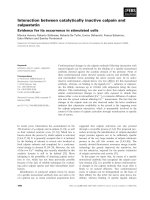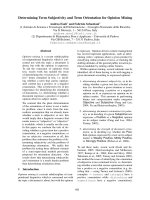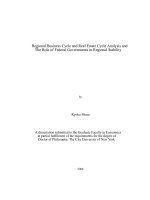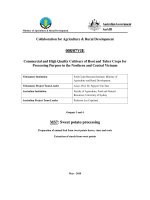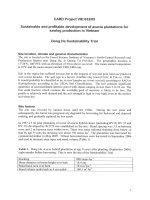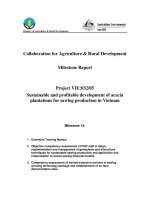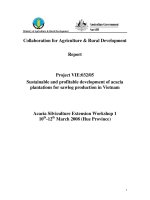Environment analysis and strategy orientation for local retailers in Vietnam
Bạn đang xem bản rút gọn của tài liệu. Xem và tải ngay bản đầy đủ của tài liệu tại đây (283.61 KB, 7 trang )
Nguyễn Thị Uyên
Tạp chí KHOA HỌC & CÔNG NGHỆ
125(11): 49 - 55
ENVIRONMENT ANALYSIS AND STRATEGY ORIENTATION
FOR LOCAL RETAILERS IN VIETNAM
Nguyen Thi Uyen*
Vietnam University of Commerce
SUMMARY
After January 11, 2015, Vietnam will fully open retail market to foreign companies what create
significant pressure on local retailers. In-depth study about strategic situation and strategy
orientation of Vietnamese supermarkets should be useful not only for the local supermarkets but
also for Vietnamese government to protect local firm from competition of foreign retailers. Based
on the data that is collected from investigation from consumers, experts’ opinion and other sources
from secondary data as well as the previous study of the author, this study has examined strategic
situation of the local supermarkets in Vietnam and generated TOWS analysis to formulate solid
strategies for local supermarkets in order to leverage their competitive advantages in Vietnam.
Key words: Vietnam Local supermarket, competitive advantage, business environment, TOWS
analysis, strategy formulation.
INTRODUCTION TO THE STUDY*
Vietnam became the WTO’s 150th member
on 12 January 2007 that brings to local
supermarkets with both opportunities and
challenges due to this internationalization.
With high potential retail market, Vietnam
has been attracting many foreign retailers and
this generates many threats on local
supermarkets. Especially under WTO
commitments, from January 11, 2010 to
January 11, 2015, Vietnam has given the right
to set up joint venture to provide services
related to production, in which foreign
investors can own up to 50 percent of the
charter capital of the joint venture. Having to
fairly competed with foreign firms even in
their home market remains a big challenge for
domestic retailers.
In the changeable environment with tough
competition, the enterprises cannot do well
without environment scanning; identifying
strategic factors to formulate strategy solidly.
The strategy formulation is the development
of long-range plans for the effective
management of environment opportunities
and threats, taking into consideration
corporate strength and weaknesses. The
formulation of strategy forces organizations
to examine the prospect of change in the
future and to prepare for change rather than to
*
Tel: 0979118679; Email:
wait passively until market forces compel it.
Therefore, a deep study on accessing current
strategic situation of local supermarket
environment, and formulate solid strategies
for the local retailers is indeed necessary for
local supermarkets in Vietnam. It does not
only make sound with Vietnamese retailers
but also create the significance to Vietnamese
Government who wants to protect local
retailers from competition and expansion of
global retailers in Vietnam.
RESEARCH
FRAMEWORK
AND
METHODOLOGY
Chandler (1962) defined strategy as "The
determination of the basic long term goals and
objectives of an enterprise and the adoption of
the courses of action and the allocation of
resources necessary for carrying out these
goals". The strategies exist at several levels in
any organization - ranging from the overall
business (or group of businesses) through to
individuals working in it.
Strategy formulation begins with a scanning
of the external as well as internal
environment.
To
formulate
effective
strategies, managers in an organization need
to be aware of realities in the business
environment.
Analysis
of
external
environment helps to identify the possible
threats and opportunities while analysis of
internal environment helps to identify
49
Nguyễn Thị Uyên
Tạp chí KHOA HỌC & CÔNG NGHỆ
strengths, weaknesses and the key people
within the organization.
The ten schools of strategy formation
proposed by Mintzberg et al. (1998) gives an
overview of the development in the field of
strategy process and demonstrate the nature
of its complexity. Of which, design School It sees strategy formation as achieving the
essential fit between internal strengths and
weaknesses and external threats and
opportunities. The formation of SWOT
matrix results in four sets of possible
strategic alternatives after matching the
company’s
internal
strengths
and
weaknesses with the external opportunities
and threats.
Based on the related theory and the results of
previous study of the author about the “key
determinant of retail performance in
Vietnam”, the author has created the research
model for this study as shown in figure 1.
Of which, Macro environment includes the
political and legal, economic, social and
cultural, technological factors. The industry
environment includes factors of competitors,
suppliers, buyers, substitutes and new
125(11): 49 - 55
entrants. The internal environment includes
the firm-specific characteristics such as: firm
size, economy of scale (Douglas & Donald,
1969; Reid, 1984), retail market strategy
(Michael and Barton, 2004); influence of
technology (Melvin and Harriet, 1992);
marketing, experience, location (Roger,
Daekwan, Jeffrey, 2006); Experiences
(Douglas & Donald, 1969); human resource
(Melvin and Harriet, 1992); Location and
property (Clifford Guy, 1994; Stepenson,8 th
edition); merchandise, product lines, square
feet of store space (Robbins, 2004; Angie
and Sarah, 2004 ).
The strategic situation of the local
supermarkets will be explored based on the
data that is collected from investigation from
consumers, experts’ opinion and other sources
from secondary data as well as the previous
study of the author. Three groups of
environment factors (macro environment,
industry environment, internal environment).
By using SWOT matrix, this study generates
alternative strategies and recommendations
for local supermarkets.
Macro environment
scanning
Industry
Environment
Analysis
Strategic Factors
Internal
Environment
analysis
Strategic Alternatives
Best strategies
Figure 1. Research Model of Environment Analysis and Strategy Orientation
(Adapted from the Strategic Decision-Making Process, Wheelen and Hunger 2001)
Data analysis of Strategic Situation of Local supermarket
External environment
As one of the countries having the fastest economic growth in the region and several forces,
many of which are interconnected: for example, increasing incomes, urbanization, more female
participation in the labor force and openness to foreign investment, opening in lifestyle of young
people, Vietnam is a potential and attractive market to foreign retailers worldwide. In the period
of 2009 - 2011, although the world’s economy in general and Vietnam’s in particular were
50
Nguyễn Thị Uyên
Tạp chí KHOA HỌC & CÔNG NGHỆ
severally affected by the economic downturn,
the retail industry in Vietnam still saw
impressive growth. In 2011, total retail sales
and consumer service revenue reached VND
2,004 billion, up 24.2 percent compared to the
previous year. In 2012, that number reached
VND 2,320 billion, up 16 percent compared
to 2011. Although it has dropped out of the
top 30 attractive retail markets in the world in
2013, according to economic experts, the
Vietnam market still attracts great interest
from large retail corporations in the world.
The report “Vietnam Retail Market Forecast
to 2014” says the modern retail channels will
play a crucial role in the future growth,
improving their position in the market.
Increasing purchasing power, changing
lifestyle, and influence of western culture are
some of the key growth drivers in the
country's modern retail market, it says, adding
that, during the next few years, a short wave
of consolidation will emerge as foreign
retailers are trying to consolidate their
position and deepen their market penetration.
Furthermore, Vietnam has a very receptive
attitude towards welcoming FDI and
developing Trade relations. The government
is committed to improve the country's
business and investment climate. So the retail
market industry in Vietnam is attracting many
international retail groups all over the world.
So Vietnamese retail businesses are meeting
with difficulties to compete with foreign
rivals and are struggling to survive (Dinh
Thanh, 2011).
However, Vietnam’s application of Economic
Needs Test (ENT) requirement before
allowing foreign retailers to open the second
retail outlets is a favorable factor for local
retailers. The Departments of Industry and
Trade will use many criteria to decide
whether to grant licenses to the opening of
supermarkets or not.
In term of Technological environment, an
estimated 2.0% of Vietnamese households
have
a
broadband-enabled
computer,
representing a significant increase from the
0.1% of households in 2005. The rapid uptake
125(11): 49 - 55
is partly as consequence of the ease and low
price of connection. According to the
Ministry of Information and Communication,
Vietnam’s internet penetration is at 35.6
percent of the total population. For number of
internet users, Vietnam has been ranked
seventh highest among the countries with
high internet use in Asia, by Internet World
Stats, that creates potential opportunity for
promoting well online marketing as well as
online retail to support offline retail in this
market. However, it also results in the strong
substitute from online retail.
In term of industry environment, according to
the statistics from the Association of Vietnam
Retailers, modern retail channel accounts for
only 20 percent, so the market to exploit
remains big and plan, by 2020, Vietnam will
have raised this rate to 45 percent. The
country currently has about 130 commercial
centers, 700 supermarkets, over 1,000 modern
retail outlets, concentrating mostly in Hanoi
and Ho Chi Minh City.
To meet the increasing living standard, the
traditional trade will be instead by modern
trade day by day. The consumption from
traditional market with unstable and smaller
size could not compete with modern retailers
in gaining power of bargaining with
suppliers. The modern retailers with bigger
size than traditional retailers have more
advantages in negotiating with suppliers.
However, the cooperation among local
supermarkets and suppliers are still very
weak. So in expert’ opinion, the suppliers
actually do not have strong bargaining power
with modern retail chains and they still have
many difficulties with this cooperation (Ms
Dinh Thi My Loan, General Secretary of the
Association of Vietnam).
In term of threat of new entrants, current
competitors, all of experts said that the
current and potential foreign competitors are
very strong competency especially after
being a member of WTO. Under WTO
commitments, from January 11, 2010 to
January 11, 2015, Vietnam has given the right
to set up joint venture to provide services
51
Nguyễn Thị Uyên
Tạp chí KHOA HỌC & CÔNG NGHỆ
related to production, in which foreign
investors can own up to 50 percent of the
charter capital of the joint venture. After
January 11, 2015, Vietnam will allow the set
up of enterprises with 100 percent foreign
capital. It means that Vietnam's retail market
will be fully open to foreign companies,
which will create significant pressure on local
businesses (Investment and Trade Promotion
Centre, 2006).
According to Investment and Trade
Promotion Centre of HochiMinh City,
recently, Vietnam's retail market has also
welcomed the participation of many big
names in the world such as Auchan, one of
the largest retail groups in France, which
announced plans to invest US$500 million in
Vietnam retail market, NUTC Fair Price.
However, most of current participants are
supermarkets and hypermarkets, so the
segment of convenient store is still available.
The threats of new entrants and the degree
of rivalry are strong negative forces. The
bargaining power of consumers also
increases along with the greater number of
strong competitors and new comers. The
customers with higher living of standard
bring opportunities for modern retail
125(11): 49 - 55
expansion but also threats of higher
requirement from customer.
The substitutes from traditional retailing,
online retailing should be taken into account
by the modern retailers. The active and young
population is enjoyable with online shopping
while the older generations prefer to keep the
habit of shopping at traditional market. The
fact indicated that the consumers with
traditional shopping habits prefer buying from
traditional market than going to modern
supermarket. Hang Da Market after upgrading
is an example proving for this reality. A lot of
Vietnamese people prefer the convenience of
the traditional market where they don’t have
to go to car park and just take a few minutes
to finish daily shopping on the way they go
back home from work. Especially, the fresh
food in traditional market is currently a
significant strength of traditional market.
Internal environment
By using the questionnaires with 5 point
rating scale to measure respondents’
evaluation by asking them the degree of
variable that ranked from (1) to (5) toward
positive extension, the statistics results from
185 respondents who are quite familiar with
shopping at supermarket indicates as follows:
Table 1. Mean statistics of respondents for characteristics of local supermarkets in Vietnam
Statistics
Location Space
Layout Brand
Sales
Force
Product
Added
PromoProduct Competitive
After sales
DiversifiValue
tion
Quality
Price
service
cation
Service
Valid
185
185
185
185
185
185
185
185
185
185
185
Missing
0
0
0
0
0
0
0
0
0
0
0
3,0919
2,2108
2,6000
2,8000
2,6108
1,9081
2,0108
4,1027
2,0054
1,9946
2,7027
Std. Deviation ,83222
,74738
,49123
,40109
,65929
,53891
,63408
,70344
,63842
,62985
,45831
N
Mean
The statistics indicated that local supermarket evaluated at quite high level of location
convenience and product quality. It means that the customers find the convenience from the local
supermarket locations and these supermarkets are good at product quality. However, the
competency in brand, layout, sales force and after sales service still moderate, especially they are
quite weak at space, promotion, value added services, product diversification and price.
It is also transparent that the local retailers will understand customer needs more deeply than the
foreigners do. Being Vietnamese firms, local retailers are also familiar to business manner of
Vietnam. This will help them to easier in penetrating the local market. Saigon Coop Mart has
taken good advantages of this strength; it localized products such as increasing fresh food at
supermarket to meet the customer requirement.
52
Nguyễn Thị Uyên
Tạp chí KHOA HỌC & CÔNG NGHỆ
However, except Saigon Coop mart, most of
local small-size supermarkets are small and
slightly poor at competitive price. They do
not have the deep cooperation with suppliers
so the price is not competitiveness.
Comparing to grant foreign retailers, the
local supermarkets are les competitive in
price (Viet Trung, 2011).
The fact also indicates that marketing
program plays important role in retailing
performance. Advertisement, promotional
program,
supported
services
for
entertainments at shopping places are
employed well at foreign supermarkets while
still poor at the local firms. Attractive
promotional
programs
at
foreign
supermarkets such as Big C always attach
crowded customers.
Discussions and Recommendations
There is no doubt about the positive effect
from modern retail that AT. Kearney, in its
15 years analysis, indicated, “modern retail
125(11): 49 - 55
drives the economy through increased
productivity, investments in capital stock,
new job creation and lower prices”. Vietnam
has potential market for retail industry and
need to stimulate the retail industry as a key
driver of the economy.
However, experience from Thailand shows
that the monopolistic power and overexpansion of foreign modern retailers can
disrupt the local economy and culture. The
global retailers has put local traditional
retailers and suppliers at a competitive
disadvantage and ultimately put those that are
unable to adapt out of business. Thus, finding
strategic solution to enhance local retailers is
necessary to create a sustainable development
for retail industry.
To formulate solid strategies for local
supermarkets based on careful environment
scanning, the SWOT matrix is quite match in
this situation and it can illustrate as follows:
Table 2. SWOT Matrix for Local Supermarkets in Vietnam
Opportunities
fair and healthy
market
Growing market
High demand for a
new and modern retailing
Favorable Culture and
social trend
Regulation
to
constraint expansion of
foreign retailers
Strengths:
Young and dynamics
Understand well local customer
needs
Familiar to business manner of
Vietnam
Reliable quality
Weakness:
Weak financial resource
Small size, poor space
Poor product line.
Slightly poor competitive
price
Moderate in sales and
Management Skills
Poor after-sales service
Poor relationship with
suppliers
Poor marketing and R&D
competency
SO strategies
- Market Penetration strategy: focus
on R& D and Marketing to strengthen
image and services
- Niche marketing: setting up local
convenient store or small size of
supermarket which match to local
customer needs
- Being First mover to take
advantages of government policy in
constraining expansion of foreign
retailers.
WO strategies
Diversification
strategy:
diversify product lines
- Merge and alliance strategy:
small
local
firm
should
integrated to enhance capacity
Strong
Integrated
with
suppliers
- Focus on Marketing and R&D..
Combine online marketing with
traditional marketing
53
Nguyễn Thị Uyên
Tạp chí KHOA HỌC & CÔNG NGHỆ
125(11): 49 - 55
Niche markets of
convenient retail still
available for modern
retailers
Threats
Direct competition
from giant international
retailers
Higher requirement
from customers.
Modern
Retail
expansion
generate
higher bargaining power
for customers
Competition
in
setting up the sustainable
relationship
with
suppliers
ST strategies:
- Niche market focus: setting up local
convenient store or small size to
avoid direct competition of foreign
supermarket.
- Apply e-commerce software such as
CRM, CPM, EPR... to strengthen
competency and avoid threats
- Take advantage of online marketing
to stimulate firm attractiveness
WT strategies
- Strong
Integrated
with
suppliers
- Merge and alliance strategy:
small
local
firm
should
integrated to enhance capacity
- Focus on Marketing and
R&D
- Growth strategy with higher
investment
- Apply e-commerce software
such as CRM, CPM, EPR... to
reduce operating cost and
strengthen relationship with
partner
The TOWS matrix plays an important role in suggesting the strategic alternatives so the theories
of strategy formulation should consider the TOWS matrix as an important part in the process of
generating the solid strategies.
REFERENCE
1. Cox Roger and Brittain Paul (2004) Retailing: an introduction, Prentice Hall.
2. Guy Clifford (1990). The retail development process: location, property and planning: London and
Newyork.
3. Stephen (2005). Organizational Behavior: Prentice-Hall.
4. J. Calantone Roger, Kim Daekwan, B.Schmidt Jeffrey, Cavusgil S. Tamer, (2006). The influence of
internal and external firm factors on international products adaptation strategy and export performance: A
three-country comparison, Journal of Business Research,59, pp. 176-185.
5. Miller, A . and Dess, G. G . (1993), Assessing Porter's (1980) Model in Terms of Its General isability,
Accuracy and Simplicity, Journal of Management Studies, 30(4).
6. Miller, D., & Friesen, P. H . (1983). Strategy making and environment: The third link, Strategic
Management Journal, 4, pp. 221-235.
7. Nguyen Thi Uyen, The Key determinants of retail performance in Vietnam, MBA thesis of
University of the Thai Chamber of Commerce.
8. Porter, M. E. (1985). Competitive advantage: Creating and sustaining superior performance.
9. Tanabe Mario, Claudio De Angelo Flisoni and Alexander Nicholas (2004) The effectiveness of
Strategic planning competitiveness in the Brazilian supermarket sector, Jounal of Retailing and
consumer services,11(1), pp.51-59.
54
Nguyễn Thị Uyên
Tạp chí KHOA HỌC & CÔNG NGHỆ
125(11): 49 - 55
TÓM TẮT
PHÂN TÍCH MÔI TRƯỜNG VÀ ĐỊNH HƯỚNG CHIẾN LƯỢC
CHO CÁC DOANH NGHIỆP BÁN LẺ NỘI ĐỊA TẠI VIỆT NAM
Nguyễn Thị Uyên*
Đại học Thương mại
Việc mở cửa hoàn toàn thị trường bán lẻ cho các công ty nước ngoài vào ngày 11 tháng 1 năm
2015 của Việt nam sẽ tạo ra những sức ép lớn cho các nhà bán lẻ trong nước. Chính vì vậy, việc
nghiên cứu sâu về tình thế môi trường để định hướng chiến lược cho các các siêu thị trong nước
hiện nay đang là vấn đề cấp thiết đối với các siêu thị nội địa cũng như chính phủ trong việc bảo vệ
các siêu thị này trước sự cạnh tranh khốc liệt từ các siêu thị nước ngoài. Trên cơ sở nguồn dữ liệu
thu thập từ điều tra khách hàng, ý kiến chuyên gia và các nguồn thứ cấp cũng như từ chính nghiên
cứu trước đây của tác giả, bài viết này chỉ rõ tình thế chiến lược của các siêu thị trong nước và vận
dụng mô thức TOWS để định hướng chiến lược cho các doanh nghiệp này nhằm tạo ra lợi thế cạnh
tranh trên thị trường bán lẻ Việt nam.
Từ khóa: Siêu thị nội địa của Việt nam, lợi thế cạnh tranh, môi trường kinh doanh, phân tích
TOWS, hoạch định chiến lược.
Ngày nhận bài:09/4/2014; ngày phản biện:25/4/2014; ngày duyệt đăng: 26/9/2014
Phản biện khoa học: TS. Nhâm Phong Tuân – Đại học Quốc gia Hà Nội
*
Tel: 0979118679; Email:
55

